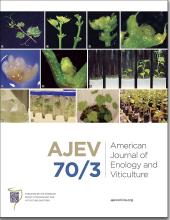Abstract
Spoilage by Brettanomyces bruxellensis is a major concern for the wine industry. The negative effect of this yeast on wine quality, that is, potentially large associate economic losses and the production of phenolic off-flavors, requires application of specific control measures. We investigated the ability of ozone to control the B. bruxellensis population on treated Barbera winegrape berries, and the impact on subsequent winemaking or fermentation. To further explore the ability of ozone treatments to reduce the B. bruxellensis population, a mix of three different strains was artificially inoculated onto the surface of grape berries. Grape berries were ozone-treated either in aqueous (6 or 12 min) or gaseous form (12 or 24 hr), crushed, then fermented to evaluate the effect of these treatments on B. bruxellensis and Saccharomyces cerevisiae growth dynamics and wine composition. Microbiological analysis revealed a significant reduction in B. bruxellensis of ~2.2 log colony forming units (CFU)/mL after treatment with gaseous ozone for 24 hr. The wines produced from grape berries previously exposed to gaseous ozone for 24 hr contained the lowest levels of acetic acid. Moreover, 4-ethylphenols were detected in wines produced from grape berries treated with water (6 or 12 min), in which B. bruxellensis population reached 5.0 log CFU/mL at the end of fermentation. Molecular analysis suggested that the three tested strains had similar sensitivity to the ozone treatments applied. This study shows the first results about the ability of ozone to control the population of different B. bruxellensis strains within the same species in the same manner.
- Received June 2018.
- Revision received December 2018.
- Accepted January 2019.
- Published online July 2019
- ©2019 by the American Society for Enology and Viticulture
Sign in for ASEV members
ASEV Members, please sign in at ASEV to access the journal online.
Sign in for Institutional and Non-member Subscribers
Log in using your username and password
Pay Per Article - You may access this article (from the computer you are currently using) for 2 day for US$10.00
Regain Access - You can regain access to a recent Pay per Article purchase if your access period has not yet expired.










